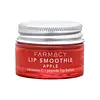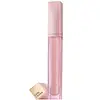What's inside
What's inside
 Key Ingredients
Key Ingredients

 Benefits
Benefits

 Concerns
Concerns

 Ingredients Side-by-side
Ingredients Side-by-side

Hydrogenated Polyisobutene
EmollientDiisostearyl Malate
EmollientPhytosteryl/Isostearyl/Cetyl/Stearyl/Behenyl Dimer Dilinoleate
Skin ConditioningCaprylic/Capric Triglyceride
MaskingPolybutene
Mangifera Indica Seed Butter
Skin ConditioningSynthetic Wax
AbrasiveEthylene/Propylene/Styrene Copolymer
Euphorbia Cerifera Wax
Brassica Campestris/Aleurites Fordi Oil Copolymer
Skin ConditioningButyrospermum Parkii Butter
Skin ConditioningTetrahexyldecyl Ascorbate
AntioxidantPalmitoyl Tripeptide-1
Skin ConditioningPyrus Malus Fruit Extract
Skin ConditioningGlycerin
HumectantMoringa Oleifera Seed Oil
EmollientCurcuma Longa Leaf Extract
Skin ConditioningSolanum Melongena Fruit Extract
Skin ConditioningCoccinia Indica Fruit Extract
Skin ConditioningOcimum Sanctum Leaf Extract
Skin ConditioningCorallina Officinalis Extract
Skin ConditioningMelia Azadirachta Leaf Extract
Skin ConditioningMelia Azadirachta Flower Extract
Skin ConditioningMelia Azadirachta Extract
Skin ConditioningTocopherol
AntioxidantTribehenin
EmollientEthylhexyl Palmitate
EmollientGlyceryl Caprylate
EmollientMalic Acid
BufferingLactic Acid
BufferingSorbitan Isostearate
EmulsifyingAmber Powder
Pentaerythrityl Tetra-Di-T-Butyl Hydroxyhydrocinnamate
AntioxidantButylene/Ethylene/Styrene Copolymer
Aroma
Limonene
PerfumingHydrogenated Polyisobutene, Diisostearyl Malate, Phytosteryl/Isostearyl/Cetyl/Stearyl/Behenyl Dimer Dilinoleate, Caprylic/Capric Triglyceride, Polybutene, Mangifera Indica Seed Butter, Synthetic Wax, Ethylene/Propylene/Styrene Copolymer, Euphorbia Cerifera Wax, Brassica Campestris/Aleurites Fordi Oil Copolymer, Butyrospermum Parkii Butter, Tetrahexyldecyl Ascorbate, Palmitoyl Tripeptide-1, Pyrus Malus Fruit Extract, Glycerin, Moringa Oleifera Seed Oil, Curcuma Longa Leaf Extract, Solanum Melongena Fruit Extract, Coccinia Indica Fruit Extract, Ocimum Sanctum Leaf Extract, Corallina Officinalis Extract, Melia Azadirachta Leaf Extract, Melia Azadirachta Flower Extract, Melia Azadirachta Extract, Tocopherol, Tribehenin, Ethylhexyl Palmitate, Glyceryl Caprylate, Malic Acid, Lactic Acid, Sorbitan Isostearate, Amber Powder, Pentaerythrityl Tetra-Di-T-Butyl Hydroxyhydrocinnamate, Butylene/Ethylene/Styrene Copolymer, Aroma, Limonene
Petrolatum
EmollientPentaerythrityl Tetraisostearate
EmollientBis-Diglyceryl Polyacyladipate-2
EmollientCaprylic/Capric Triglyceride
MaskingPEG-8 Beeswax
EmulsifyingMethyl Methacrylate Crosspolymer
Silica
AbrasiveMacrocystis Pyrifera Extract
Skin ConditioningTriticum Vulgare Bran Extract
Skin ConditioningTriticum Vulgare Germ Extract
Skin ConditioningHordeum Vulgare Extract
EmollientPalmitoyl Tripeptide-1
Skin ConditioningOlea Europaea Fruit Extract
BleachingPolybutene
Salicornia Herbacea Extract
Skin ConditioningOleic Acid
EmollientPhoenix Dactylifera Fruit Extract
EmollientSqualane
EmollientMoringa Oil/Hydrogenated Moringa Oil Esters
Skin ConditioningBrassica Campestris Sterols
EmollientCrithmum Maritimum Extract
Skin ConditioningCholesterol
EmollientOlea Europaea Fruit Oil
MaskingTetrahexyldecyl Ascorbate
AntioxidantSodium Hyaluronate
HumectantAcetyl Glucosamine
Skin ConditioningEthylhexyl Palmitate
EmollientRicinus Communis Seed Oil
MaskingGlyceryl Stearate
EmollientPolydecene
Skin ConditioningDimethicone
EmollientTocopheryl Acetate
AntioxidantHydrogenated Castor Oil
EmollientAcrylates Copolymer
Palmitic Acid
EmollientTribehenin
EmollientButylene Glycol
HumectantHydrogenated Vegetable Oil
EmollientSaccharin
MaskingSorbitan Isostearate
EmulsifyingSynthetic Fluorphlogopite
Potassium Sulfate
Vanillin
MaskingParfum
MaskingWater
Skin ConditioningAlumina
AbrasivePolyethylene Terephthalate
Tin Oxide
AbrasiveCalcium Sodium Borosilicate
Calcium Aluminum Borosilicate
Mica
Cosmetic ColorantCI 77491
Cosmetic ColorantCI 77492
Cosmetic ColorantCI 77499
Cosmetic ColorantCI 77891
Cosmetic ColorantCI 19140
Cosmetic ColorantCI 77400
Cosmetic ColorantCI 15850
Cosmetic ColorantCI 45410
Cosmetic ColorantCI 73360
Cosmetic ColorantCI 75470
Cosmetic ColorantCI 77163
Cosmetic ColorantCI 42090
Cosmetic ColorantCI 15985
Cosmetic ColorantCI 17200
Cosmetic ColorantCI 45370
Cosmetic ColorantCI 77742
Cosmetic ColorantCI 45380
Cosmetic ColorantPetrolatum, Pentaerythrityl Tetraisostearate, Bis-Diglyceryl Polyacyladipate-2, Caprylic/Capric Triglyceride, PEG-8 Beeswax, Methyl Methacrylate Crosspolymer, Silica, Macrocystis Pyrifera Extract, Triticum Vulgare Bran Extract, Triticum Vulgare Germ Extract, Hordeum Vulgare Extract, Palmitoyl Tripeptide-1, Olea Europaea Fruit Extract, Polybutene, Salicornia Herbacea Extract, Oleic Acid, Phoenix Dactylifera Fruit Extract, Squalane, Moringa Oil/Hydrogenated Moringa Oil Esters, Brassica Campestris Sterols, Crithmum Maritimum Extract, Cholesterol, Olea Europaea Fruit Oil, Tetrahexyldecyl Ascorbate, Sodium Hyaluronate, Acetyl Glucosamine, Ethylhexyl Palmitate, Ricinus Communis Seed Oil, Glyceryl Stearate, Polydecene, Dimethicone, Tocopheryl Acetate, Hydrogenated Castor Oil, Acrylates Copolymer, Palmitic Acid, Tribehenin, Butylene Glycol, Hydrogenated Vegetable Oil, Saccharin, Sorbitan Isostearate, Synthetic Fluorphlogopite, Potassium Sulfate, Vanillin, Parfum, Water, Alumina, Polyethylene Terephthalate, Tin Oxide, Calcium Sodium Borosilicate, Calcium Aluminum Borosilicate, Mica, CI 77491, CI 77492, CI 77499, CI 77891, CI 19140, CI 77400, CI 15850, CI 45410, CI 73360, CI 75470, CI 77163, CI 42090, CI 15985, CI 17200, CI 45370, CI 77742, CI 45380
 Reviews
Reviews

Ingredients Explained
These ingredients are found in both products.
Ingredients higher up in an ingredient list are typically present in a larger amount.
This ingredient is an emollient, solvent, and texture enhancer. It is considered a skin-softener by helping the skin prevent moisture loss.
It helps thicken a product's formula and makes it easier to spread by dissolving clumping compounds.
Caprylic Triglyceride is made by combining glycerin with coconut oil, forming a clear liquid.
While there is an assumption Caprylic Triglyceride can clog pores due to it being derived from coconut oil, there is no research supporting this.
Learn more about Caprylic/Capric TriglycerideEthylhexyl Palmitate, also known as octyl palmitate, is created from 2-ethylhexyl alcohol and palmitic acid. It is a fatty acid ester.
The fatty acid content of Ethylhexyl Palmitate makes it an emollient. Emollients help soften and hydrate your skin by trapping moisture within.
Ethylhexyl Palmitate is also used to help improve the texture of cosmetics. It helps other ingredient dissolve in products and help disperse ingredients more evenly.
You'll likely find this ingredient in sunscreen, as it is often used to mix UV-blocking ingredients such as avobenzone and ethylhexyl triazone.
It can also help stabilize the fragrances in a product as a fragrance fixative.
Ethylhexyl Palmitate can be used to substitute mineral oil.
Due to its high fatty acid content, it may not be fungal-acne safe.
Learn more about Ethylhexyl PalmitatePalmitoyl Tripeptide-1 is also known as pal-GHK. It is made up of 3 amino acids and palmitic acid, a fatty acid that helps it absorb into skin more easily.
This peptide is as a signal peptide, meaning it tells the skin to produce more collagen. Collagen is the key protein that helps form the skin's structure and keep it plump, firm, and hydrated.
By boosting collagen production, this ingredient supports a stronger skin barrier and helps reduce the appearance of wrinkles.
You'll most likely see this ingredient paired with Palmitoyl Tetrapeptide-7 in the well-known Matrixyl 3000 complex. While results from in-house testing should be viewed cautiously, this peptide duo is among the most studied and widely used in modern skincare.
Due to its palmitic acid base, this ingredient may not be safe for Malassezia folliculitis.
Read more about other common types of peptides here:
Learn more about Palmitoyl Tripeptide-1Polybutene is used to help control the viscosity of a product. This just means it helps adjusts the texture.
It is a polymer and does not get absorbed into the skin due to its large size.
Studies found this ingredient did not irritate skin in concentrations below 15%.
Learn more about PolybuteneSorbitan Isostearate is an emulsifer and cleaning agent. It is created from isostearic acid and sorbitol.
As an emulsifier, Sorbitan Isostearate prevents oils and water from separating.
Due to its isostearic acid base, it may not be safe for Malassezia or fungal acne.
Learn more about Sorbitan IsostearateTetrahexyldecyl Ascorbate (THD) is a stable and oil-soluble form of Vitamin C.
THD is special in that it has the ability to travel deeper into skin than traditional ascorbic acid while maintaining the same skin benefits (double win!).
Because it’s oil-soluble, THD dives deep into your skin’s fatty layers (think ceramides and cholesterol) to fight off the kind of free radicals that mess with your skin barrier. This makes it a great pair with water-based vitamin C (ascorbic acid) that mainly works on the surface.
Even at just 0.1%, THD is already showing great antioxidant activity. When used up to 2%, it helps keep your skin happy and calm, especially when it’s stressed from pollution or sun.
Want to fade dark spots or tackle hyperpigmentation? You’ll want 5% or more. Pairing it with brightening buddies like niacinamide or licorice root gives even better results. One study even used 30% THD with other brighteners and saw real results on stubborn discoloration, even in melasma-prone skin.
A note on THD: It’s has a slightly silky, oily texture and usually shows up colorless or pale yellow (though the exact shade can vary by supplier).
While you can sneak it into water-based formulas, it really shines when paired with silicones or oils, which help your skin soak it up better.
THD is pretty stable, but it’s still vulnerable to degradation like ascorbic acid. Too much light or heat (above 113°F / 45°C) can break it down over time. Go for dark and opaque packaging that keeps it safe and shady!
Read more about other types of Vitamin C:
Learn more about Tetrahexyldecyl AscorbateTribehenin comes from glycerin and behenic acid.
It is used as an emollient, or moisturizer. Emollients form a thin barrier on skin to prevent moisture from escaping.
This ingredient may not be Malassezia folliculitis, or fungal-acne safe.
Learn more about Tribehenin